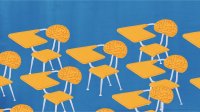What Do Teachers Need to Know About Memory?
A knowledge of how we store and use information is invaluable for teachers in helping students to internalize lessons in long-term memory.
Your content has been saved!
Go to My Saved Content.One of the most important aspects of learning that might be least understood is human memory. We are tasked with passing on skills and knowledge to students—it’s the most important aspect of our job. Yet how many educators have earned degrees and teaching certificates without any mention of how memory works? How often is human memory a topic of a book study or professional development session? I earned my teaching degree 15 years ago and don’t remember one session of any class on the topic. Any professional development I’ve received on the topic of memory has been rare, or I’ve had to seek it out on my own.
I don’t know of any teachers who don’t want to do what’s best for their students, and being able to produce instruction and a learning environment that are efficient and effective for learning requires knowledge of memory processes and a basic understanding of how to work within the constraints of human memory.
So what do teachers need to know about memory?
Guiding Students to Move Their Learning to Long-Term Memory
Senses and sensory memory: This may seem obvious, but the very first step to remembering is sensation—students have to sense the material. Most of the time, in school this equates to seeing and/or hearing the information. This is a necessary first step, but it is quite fleeting on its own. For instance, right now you are sensing a large amount of information. Practically, in the classroom teachers need to create an environment where it is as easy as possible for students to sense the material. While it’s not currently the most popular idea in education, I have all of my students face the front of my room, where information is mostly presented. This increases the odds they will visually sense the necessary material.
Attention: This brings us to attention. If students don’t give attention to those sensations, memory is null. To use a current education buzzword, this is engagement. Engagement is what the brain attends to. It is an act of cognition. Obviously, this is of extreme importance with respect to learning. Where students place their attention is where they have an opportunity to learn. Is it focused on the necessary stimulation for learning or on a phone screen? Or is it split between multiple sensations?
In my classroom, I want to make it as easy as possible for students to spend their attention on what’s most important for learning. This means I create an environment as free from distractions as possible, by considering what manipulatives they may have on their desk, what decorations I have on the walls, how clearly and concisely I present material, and the physical setup of desks and chairs.
Working memory: If students sense and attend to the learning material, the information may be understood and encoded in their working memory. To put it simply, the conscious thought you are having right now is what is present in your working memory—it is the information you are cognitively working with. But again we see that although this is a very necessary step, it is not sufficient for long-term retention of material. Working memory is quite fleeting both in its capacity to process information at any given time and in how long it will hold that information without rehearsal. To a certain degree, it’s a bit like a funnel for information—only so much material can make its way through without being lost, so it’s imperative that teachers carefully monitor the cognitive complexity of our classroom and the lessons we design.
For instance, in my classroom this means keeping the main thing the main thing—what is absolutely necessary for my students to encounter and understand for learning? For the most part, everything that our students attend to and engage with places a load on their working memory. If instructional design is too complicated, or not explicit enough as to what students should focus on, they may not have room in their working memory for the necessary stimulation for processing because they are focusing on the wrong information. Instructional design should remain simple, especially for new and/or complicated material.
I’m not saying that classrooms and lessons should be almost depressingly bland, but with every new piece of information or diagram or manipulative that students encounter, the load on their constrained working memory is increased. Choose wisely.
Long-term memory: As best we know, unlike working memory, long-term memory is limitless both in its capacity and in the length of time it can hold memories. From a practical standpoint, this should be a goal of the educator: getting the pertinent information to the students’ long-term memory. While it would be fantastic if the memories of classroom material automatically processed into long-term memory, that is usually not the case. For most classroom material, this requires effortful processing.
Two of the best evidence-based learning strategies for this are retrieval practice and spaced practice. These strategies require, at differing times, for students to access their memories of the material and effortfully use and apply their knowledge. What’s quite interesting about this is when students retrieve these memories, they are now in working memory.
Generally speaking, the more we rehearse the recognition or recall of memories, the stronger and more efficient they become. Even though a student may remember something from one day to the next, indicating it’s part of their long-term memory, that doesn’t mean it is necessarily accessible forever—an unused memory may be forgotten or irretrievable. Practicing utilizing knowledge is imperative both as an assessment of learning and for learning.
